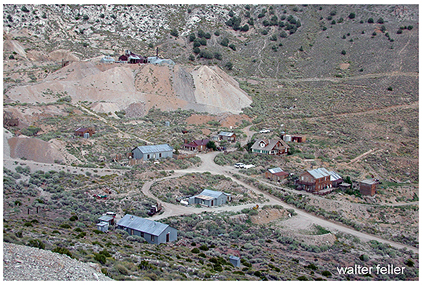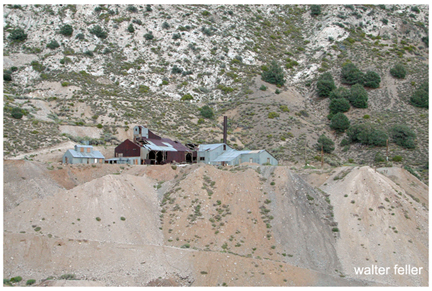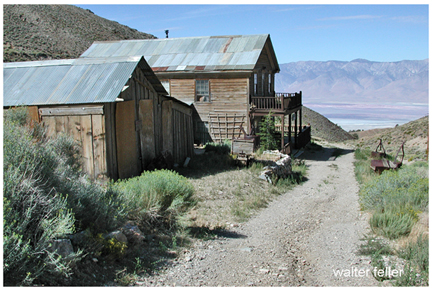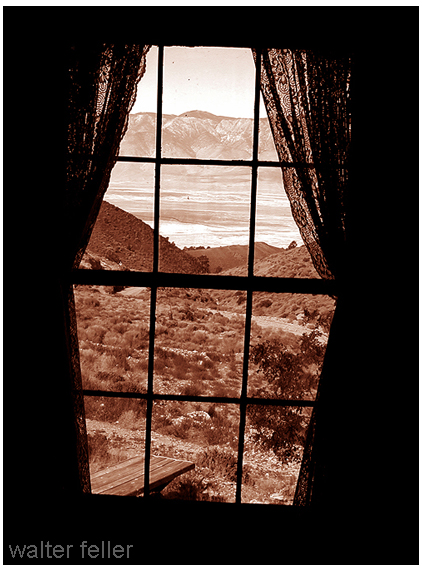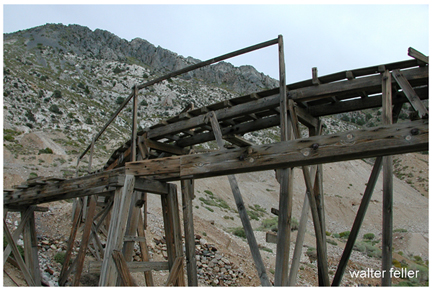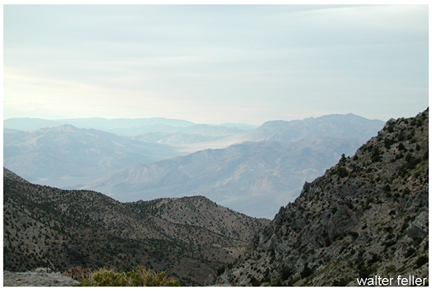Cerro Gordo
Cerro Gordo stands undisputedly as the Inyo County camp of greatest production, notwithstanding that no one knows, within some millions, what the total was. About $13,000,000 was the estimate at the close of its first period of life. The boom spirit of mining writers some twenty years ago raised the statement to $28,000,000, apparently just for the sound of it. The best available information is that the actual gross production of the camp's best days was approximately $17,000,000.Tradition long current in Inyo, and supported by pioneers of the old camp, has it that the first discovery was made by one Pablo Flores and two other Mexicans in 1865; that the companions of Flores were killed by Indians and that he was allowed to go after promising never to return. A letter written from the camp in 1868 said only that Flores had found some very rich float while traveling from the eastward with an Indian guide.
Another version was current and believed in Virginia City, Nevada, at the time of Cerro Gordo's prosperity. It ran that a packer named Savariano, employed by a Comstock Mexican mine owner, ran away with a packtrain of forty mules laden with very rich ore. This he was supposed to take to Placerville for reduction, and he started according to program. When out of sight of his employer he headed south with the whole cavalcade. On this trip he was said to have found the Cerro Gordo mines. A Virginia paper said the absconding of Savariano was a matter of common knowledge. Be that as it may, the Flores version was accepted by Inyoites, including those who knew the old Mexican up to the time of his death near Owens Lake.
Flores and a few companions were on the ground later in 1865 and located the Ygnacio, San Felipe and San Francisco claims. A small amount of ore was worked in the vesos, or crude furnaces. Their success brought a few Americans to the camp; the latter people made some locations, but did little or no work.
The first sincere effort at development was made by a Mexican named Ochoa, who began work on a claim known as the San Lucas. He employed a few of his countrymen, and had the ore worked at the Silver Sprout mill, west of Independence. An increased number of miners came, and on April 5, 1866, Lone Pine district, including the new camp, was organized, with J. J. Moore as its Recorder. The first claim offered for record was the Jesus Maria. On January 1, 1870, 999 locations had been filed for record in the district.
Among the early arrivals were M. W. Belshaw and A. B. Elder. After examination they left, but soon returned to begin development. Elder was succeeded by Victor Beaudry. Belshaw & Beaudry remained the bonanza firm of the hill; with them were associated Egbert Judson and others as parties in interest.
To supply the water required for the camp Belshaw & Beaudry laid a pipe line, which froze and bursted the following winter, and was then replaced by a better system. The firm began acquiring control of "the hill," as the camp was generally called throughout the region. Among their purchases was a group of four claims for which they paid John B. White and P. Williams $20,000. Important ground adjoining the Union, one of their chief properties, remained independent, however, and under the same ownership as the Owens Lake Silver-Lead Company later became the basis of the suit which helped to check operations.
C.F.R. Hahn, the mystery of whose loss has been mentioned in this record, was one of the discoverers of wholly new ground to the eastward of the main camp. W. L. Hunter, John Beveridge and others of honored Inyo memory were also among the owners in the eastern section.
Two slagging furnaces, two blast furnaces, crusher, blower and other equipment were in use in the camp by 1870, all operated by steam and all well housed. In 1871 the use of slagging furnaces was done away with, decreasing expenses $50 a day at each furnace. Another improvement was the application of the water jacket, first devised and used by Belshaw.
One of the first undertakings was a tollroad up from Owens Valley, a few miles distant. The road was held by Belshaw & Beaudry, though others assisted in its building for the benefit of their own properties. Those others found themselves on the same footing as strangers when it came to paying tolls. Their objections ended with complaints until 1871, when citizen John Simpson was arrested for misdemeanor in passing the tollgate without paying. To secure a jury used up venires amounting to ninety men ; the Justice court trial filled two days, and ended in a verdict of not guilty. A popular subscription was immediately raised and a free road was built to Cerro Gordo. The toll road went out of commission.
Two stage companies ran daily conveyances from Lone Pine, every vehicle carrying full loads. A through-service line ran between Aurora, Nevada, and Cerro Gordo, charging $39 for the trip.
When the not always dependable pipe lines were out of order, water was brought in on pack mules and sold at 10 cents per gallon for the small buyer and from 5 to S% cents for the wholesale consumer. The water bill of the American Hotel was $300 a month, and each furnace and the Union hoist ran at a daily expense of $120 for water. Fifty pack mules were busy in the water service.
In 1872 Beaudry bought the San Lucia (or San Lucas) and added it to the syndicate's list. Eleven producing mines were being operated. In addition to the furnaces at the camp, ore was being smelted at the Owens Lake Silver-Lead company's plant at Swansea, at the lake.
While the bulk of production came from ores of more moderate grade, values up to $800 or more per ton were too common to attract much attention. One of the mines counted rock carrying 180 ounces of silver as its second-class grade. Beaudry reported in 1872 that ''the mine" (probably the Union) was sending up 70 tons of ore each ten hours. He was about to increase his furnace capacity to ten tons of bullion daily. Each furnace was then turning out 100 to 150 83-pound bars each twenty-four hours.
Transportation of the bullion was a problem, and it was not unusual for the furnaces to shut down because of being too far ahead of the teams. For a while hauling contracts were made with any and all comers, but this proved unsatisfactory, and the mine owners organized the Cerro Gordo Freighting Company. They associated Nadeau, a teamster, with them; he took active charge, and made a fortune from the service. The corporation became the dominant factor in Liyo transportation, and so remained up to the advent of the railroad. The line was equipped with huge wagons, each hauled by sixteen to twenty animals. Fiftysix of these outfits were on the road, and still could not move the bullion to tidewater half as fast as it rolled from the furnaces. Some relief was given by the building of the small steamer Bessie Brady, a craft of 85 feet length and 16 feet beam. This vessel plying between Swansea, at the northeastern comer of the lake, Ferguson's Landing, at the northwestern, and Cartago, at the southwestern, took eight days out of the round trips of the teams, yet the increased number of trips of the wagons could not move the bullion fast enough. To see the bullion piled up like cordwood at different points was quite the usual thing. Piled up bars were sometimes used for constructing temporary shelters, by those without other resources. While the bullion was not high grade, those shacks were often worth more money than their occupants ever dreamed of possessing.
A contemporary estimate stated the bullion output in tons as follows : 1869, 1,000 ; 1870, 1,500; 1871, 2,500; 1872, 4,000; 1873, 5,000; 1874, 6,000. An authentic record of at least part of the output is afforded by the records of the Los Angeles and San Pedro Railroad, opened November 1, 1869. From that date to the end of 1870 the road carried 21,704 bars, 1,589,000 pounds of Cerro Gordo bullion; 1871, 51,000 bars, 4,491,000 pounds; 1872, 62,390 bars, 5,303,150 pounds ; 1873, 58,056 bars, 4,826,741 pounds; during January, 1874, 9,570 bars, 789,961 pounds. During some of the period of greatest production a large part of the bullion did not go over that road.
Large mining locations were permitted. The Santa Maria, for example, was 3,000 feet in length, though but 150 feet wide. It was 1872 before any change was made in the district; it was then reorganized under the name of Cerro Gordo and regulations were adopted conforming to the newly made Federal requirements.
The San Felipe claim was one that Belshaw & Beaudry were unable to secure. Inspection of a map of the district shows that its boundaries crossed Belshaw's ground, outlining an area to which both ownerships laid claim. Ore had been coming up through the Union shaft, near the doubly-claimed ground, for five years, however, before the inevitable litigation began. Suit was started in January, 1873, by the San Felipe company, Galen M. Fisher, Chas. H. Wheeler and Alfred Wheeler, plaintiffs, against Belshaw & Beaudry, to recover possession of 2,100 feet of the San Felipe mine—another illustration of the generous manner in which the locators had helped themselves. The plaintiffs also asked for $20,000 damages, and rents and profits amounting to $1,000,000; also for possession of the San Felipe tunnel and $15,000 damages on that account. The suit was tried in Independence in June, 1873, and occupied nine days. Judge Belden of San Jose, presiding, instructed the jury that if it found that the San Felipe and Union veins were separate its verdict should be for the latter company. Experts Goodyear, Price and Henscli swore to the distinct character of the two properties. Reports of the case may have been somewhat prejudiced, but rather favored the Union contention; nevertheless the San Felipe people were given possession of the disputed ground. The demands for damages seem to have been dropped, for they do not appear in the judgment. The suit dragged through the courts until in 1876 the warring interests united in forming the Union Consolidated Company, with representatives of each side on the directorate. Belshaw was one of the directors, but did not thereafter participate in the management. The Union works were burned August 14, 1877; the furnaces closed down the following February.
Other properties, notably the Ygnacio, had been contributing to the camp's production during all this period; but the stoppage of work on the Union marked the end of that era of Cerro Gordo 's activity. The verdict that the mines were worked out was of course commonly accepted ; the fallacy of this belief was to be amply demonstrated later. From December 1, 1873, to November 1, 1874, the Union produced 12,171 tons of ore averaging 87 ounces silver and 47 per cent lead per ton. "With silver worth $1.29 per ounce and lead worth 5 cents per pound, conditions were more favorable than those which came along later. On the other hand, other conditions were much less favorable. The daily cost of water, already mentioned, was but a small item in the total. Transportation for machinery and supplies in, and bullion out, cost from $55.50 to $120 per ton. Wood had been abundant when the first work was done, but the hillsides near at hand were soon swept bare, and fuel rose to $10 a cord for wood and 32 cents a bushel for charcoal, the only fuels available for the furnaces. Belshaw stated in 1876 that it cost $19.62 a ton to mine and work the ore. In the earlier days, average recovery of metal was from 50 to 65 per cent of the lead and 90 per cent of the silver.
An incident of the camp was the discovery that much quartz richly laden with gold had gone over the dump as waste. Its value had been hidden by peculiar discoloration. Thousands of dollars of it were stolen by men who became informed sooner than did the mine management.
One company or lessee after another undertook to work the old mines after the Union Consolidated people quit, but for three decades the record was one of failure. Then in 1911 Louis D. Gordon took hold, after discovering that quantities of zinc ores had been thrown away or disregarded by former managements. He proceeded with development along original lines, under discouraging circumstances, with such results that Cerro Gordo once more made Inyo the leading California county in lead and silver as well as zinc production.
